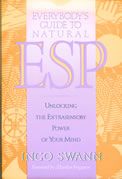|
Everybody's Guide to Natural ESP is a clearly written book designed for the lay person as an introduction to the psychic perception of predominantly visual imagery, a process often called "remote viewing." It's a book filled with fascinating examples of remote viewing, although Mr. Swann chooses in this book to refer to the phenomenon more generally as simply ESP. But the book's true importance is largely tied to the fact that it is written by one of the few natural psychics whom the military hired to reverse engineer the remote-viewing process itself. There is gifted insight in this brief book, and those who are interested in learning about some of the early thinking of the remote-viewing phenomenon would be well-served by closely examining Swann's ideas. In my view, the most important contribution of this book begins in chapter 8 when Mr. Swann starts to deal in depth with what he calls "picture drawings." This work has an historical tie to early research by Rene Warcollier (Mind to Mind by Rene Warcollier, 1948, New York: Creative Age Press; see also "The Warcollier Experiments," The Journal of the American Society for Psychical Research, December 1939, Vol. XXXII, No. 12). Picture drawings, sometimes known as ideograms, or simply sketches, range from crude representations of a target's "gestalts" to detailed portraits of a target location. A target gestalt is the essential element of a target. For example, a target that is basically a structure on flat land would have two gestalts, one being that of a structure and the other that of land. Crude sketches that represent a target's gestalts are often called "ideograms." Ideograms often follow the topology of a target, in the sense that an ideogram of a mountain may look like an upside-down V. Picture drawings originate from a person's deep intuitions regarding a target. Often a person "feels" the target more than envisioning it, but sometimes clear images do occur and a person can sketch these. The great danger in creating picture drawings is interference with one's imagination. Information processing associated with the imagination can interfere horrifically with the raw perceptual processes of ESP, and learning how to remote view is primarily a matter of learning how to record direct psychic perceptions without letting the imagination contaminate the perceived information. Mr. Swann's book describes the role of the imagination in distorting psychically perceived informatioin in a way that is very accessible to people new to remote viewing. He offers an interesting collection of examples, and he takes the time to explain those example without utilizing RV jargon. In Mr. Swann's more advanced work, he has developed the idea of picture drawings into a system by which crude visual gestalts are accumulated and built into more complex visual descriptions. Everybody's Guide to Natural ESP is a good entry point for people who want to understand Mr. Swann's basic approach to psi functioning. It is not a "rocket science" book, but it is a coherent introduction to psychic perception written by one of the original developers of contemporary remote-viewing methodologies.
|

